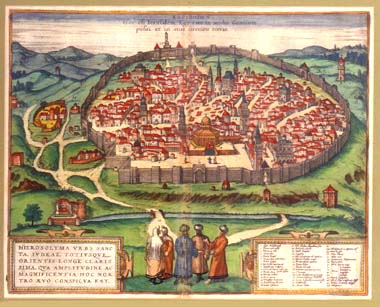 Fran
Hogenberg
Fran
Hogenberg
Hierosolyma, Clarissima toitus Orientis civitas, Iudaa Metropoli .
. .Hoc tempore Hierorsolyma turis Cuszomobarech dicitur
(Jerusalem "Pearl of the Orient,” Capital of Judea . . . Now
Known as the Jerusalem of Cuzumobarech the Turk)
from Braun and Hogenberg's Civitates Orbis Terrarum, Cologne, 1572
This map adopts the
interesting strategy of dividing Jerusalem along an imaginary temporal
rift. On the left is a fictional portrayal of the Holy City in the time
of Jesus. On the right is the “modern” city of the sixteenth
century. In the ancient panorama, the Temple is the focal point in the
events of the last days of Jesus’s life as recorded in the Gospels.
Contrasting images of Jesus’s triumphant entry into Jerusalem and
his poignant exit to Calvary bracket the city walls. In the “modern”
city, the population of Jerusalem has clearly increased, as demonstrated
by the abundance of houses and other structures. Biblical sites and gates
of the city are marked for identification in the adjacent legend, and
several mosques can be discerned by their distinctive crescents. In the
inset, Moses receives the Tablets of the Law; Aaron, his priestly garments
scrupulously annotated, stands to the right.
![]() enlarge
enlarge